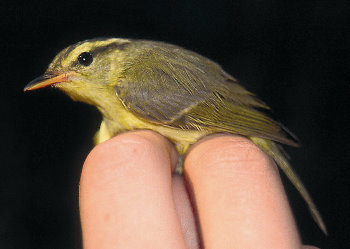A beautiful little warbler inhabiting limestone karsts in Vietnam and Laos has been named a new species. When the limestone leaf warbler ( Phylloscopus calciatilis) was first sighted in 1994 it was thought to be a member of the similar-looking species, the sulphur-breasted warbler, but ornithologists began to question that assumption when the bird produced a call significantly different from the sulphur-breasted’s.
On closer inspection, researchers found that the limestone leaf warbler has shorter wings and a larger bill proportionately than the sulpher breasted warbler’s. Olive-green with a yellow breast and striped crown, the new species is fully described in the most recent issue of the journal Ibis.
“The discovery of this new species is very exciting and underscores the importance of this region of Indochina for conservation,” said Colin Poole, Executive Director of the Asia Program for the Wildlife Conservation Society (WCS), in a press release.
 The limestone leaf warbler ( Phylloscopus calciatilis). Photo courtesy of WCS. |
While the bird is thought to be common in its preferred habitat, the forests that the bird depends on are threatened by clearing for subsistence agriculture and wood collection. Practices which threaten other recently discovered species.
“With increased attention from biologists, the Annamite mountain range of Laos in particular is revealing itself as a Lost World for new and unusual wildlife,” said Poole.
The bare-faced bulbul, a new and particularly strange bird, was discovered from the same region earlier just this year. The bare-faced bulbul (the first bulbul discovered in Asia in a century) is Asia’s only bald songbird.
In 2002, the same region revealed a species of rodent, called the kha-nyou or Laotian rock rat, which is the last representative of an entirely extinct family. Discovered by Robert Timmins of the WCS, it is considered Endangered by the IUCN Red List.
In 1999, Timmins also discovered the Annamite striped rabbit in the same area, which remains largely a mystery to biologists although it is commonly hunted.
The limestone warbler was discovered by a team of scientists from WCS, Lao PDR Department of Forestry, Swedish University of Agricultural Science, Swedish Museum of Natural History, and BirdLife International.
Citation:Description of a new species of Phylloscopus warbler from Vietnam and Laos. Per Alstro, Pete Davidson, J.W. Duckworth, Jonathan C. Eames, Trai Trong Le, Cu Nguyen, Urban Olsson, Craig Robson, and Rob Timmins. Ibis (2010), 152, 145–168.
Related articles
Photo: First bald Asian songbird discovered
(07/30/2009) Researchers have discovered a bald species of songbird in a remote part of Laos, reports the Wildlife Conservation Society. The “Bare-faced Bulbul” is the first new species of bulbul – a family of about 130 species – described in Asia in over 100 years.
Newly discovered rodent not so new or rare after all
(04/05/2006) The newly discovered species of rodent found in a marketplace in Central Laos turns out to not be so new or so rare after all. The Laotian rock rat (Laonastes aenigmamus), as the long-whiskered and stubby-legged rodent is now known, is a species believed to have been extinct for 11 million years. It is a member of a family that, until now, was only known from the fossil record. The species was first described by Wildlife conservation Society (WCS) researcher Dr. Robert Timmins after it was found on a table at a hunter’s market in central Laos. In a return trip to the market, WCS conservationist Peter Clyne found the rats to be quite common, photographing several specimens. According to Clyne, the rat is commonly brought in by hunters and eaten by local people.
Crazy jungle rodent is 11 million years old
(03/09/2006) The newly discovered species of rodent found in a marketplace in Central Laos turns out to not be so new after all. The Laotian rock rat, as the long-whiskered and stubby-legged rodent is now known, is a species believed to have been extinct for 11 million years. It is a member of a family that, until now, was only known from the fossil record.